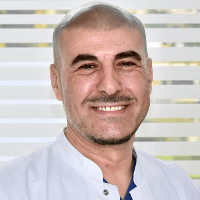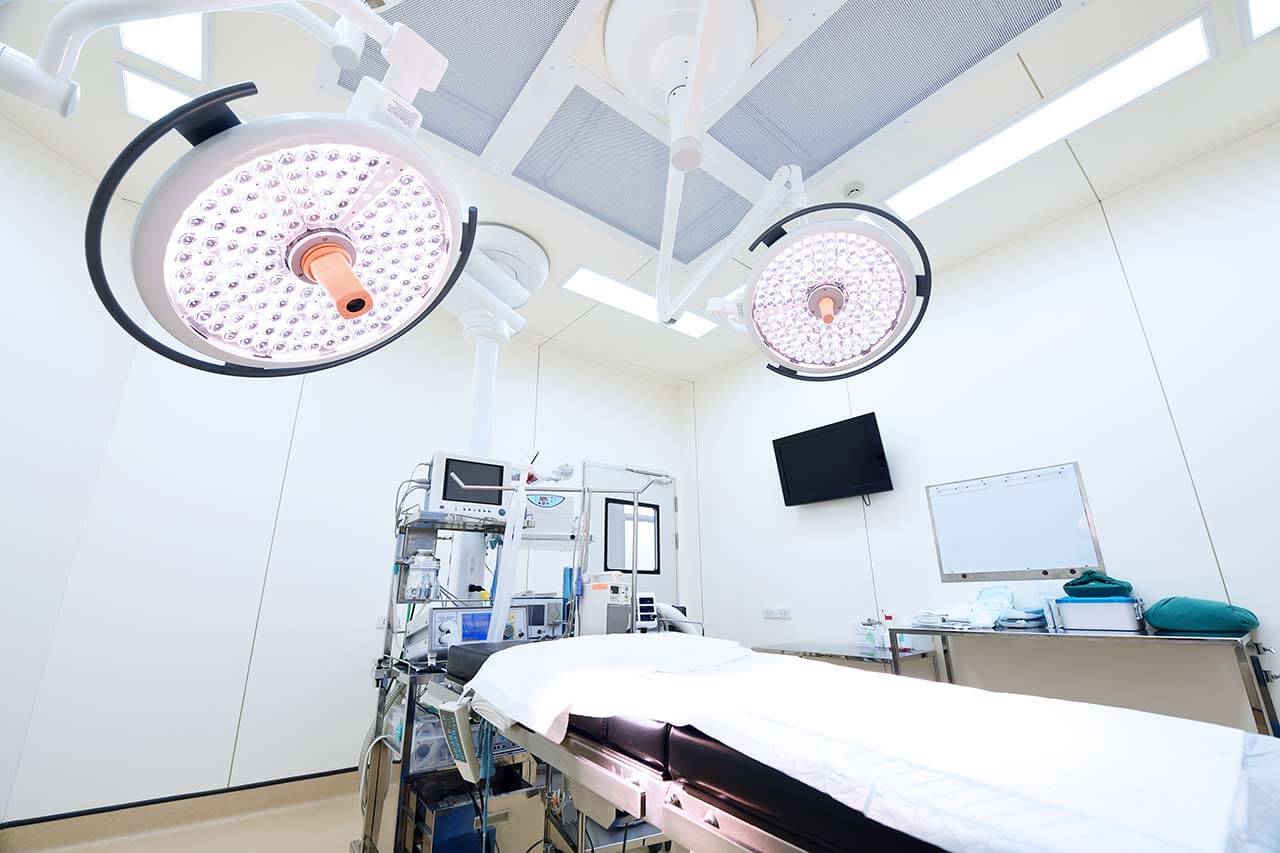
The program includes:
- Initial presentation in the clinic
- clinical history taking
- physical examination
- laboratory tests:
- complete blood count
- general urine analysis
- biochemical analysis of blood
- indicators of inflammation
- indicators blood coagulation
- x-ray/ MRI examination
- preoperative care
- neck angle correction
- neck fixator
- symptomatic treatment
- physiotherapy
- control examinations
- cost of essential medicines and materials
- nursing services
- full hospital accommodation
- Explaination of future recommendations
Required documents
- Medical records
- X-ray examination, MRI/CT scan (if available)
Service
You may also book:
 BookingHealth Price from:
BookingHealth Price from:
About the department
The Department of Spinal Surgery at the Orthopedic Center Munich East Munich offers the full range of accurate diagnostics and effective treatment of spinal diseases. The competence of the department's specialists includes minimally invasive spinal surgeries using microsurgical techniques, conservative methods for spinal diseases, intervertebral disc replacement surgery, corrective, stabilizing and dynamic interventions. The diagnostics usually involves the use of magnetic resonance imaging or computed tomography, as well as myelography. The department is one of the best medical facilities in the area of its specialization, which is confirmed by the high treatment success rates.
The department is headed by Dr. med. Samer Ismail. He is a leading specialist in spine surgery in Germany, which is confirmed by the certificate of the "Spinal Neurosurgeon" of the German Society of Neurosurgery. To date, only 25 specialists in Germany are the owners of such a certificate. This certificate testifies to a particularly high qualification in spinal surgery and allows the doctor to perform operations of the highest complexity. Since 2003, Dr. Samer Ismail has totally performed more than 12,000 operations.
The department is mainly focused on minimally invasive treatment. The minimally invasive procedures do not leave scars (or only small ones) and are usually performed on an outpatient basis. Thus, the patient has the opportunity to very quickly return to his everyday life.
In the field of intervertebral disc replacement surgery, the department has exceptional competence in the use of such methods as stabilization of the lumbar or cervical spine (PLIF, TLIF, ALIF and XLIF techniques), intervertebral disc replacement surgery and dynamic stabilization procedures. Dr. Ismail uses non-fusion (without spinal fusion) spinal surgery, which allows the patient to preserve mobility even when performing operations to fix the vertebrae.
The department pays key attention to the treatment of spinal disc herniation. In most cases, such hernias can be treated conservatively (for example, shockwave therapy). Once the comprehensive diagnostics has been completed, the department's specialists decide on the need for surgical treatment. The doctors have in their arsenal many surgical treatments, for example, nucleoplasty – minimally invasive method for the treatment of small hernias. In addition, microsurgical treatment can be performed (using a special surgical microscope). Other surgical treatments include endoscopic surgery, microsurgical decompression and interspinous spacer implantation.
The department's range of medical services includes the diagnostics and treatment of the following diseases:
- Spinal disc herniation
- Facet syndrome
- Neck pains
- Back pains
- Post-discectomy syndrome
- Scoliosis
- Spinal stenosis
- Spondylodiscitis
- Dislocated vertebrae
- Vertebral fracture
- Spinal instability
- Spinal tumors
- Compression syndrome
- Other spinal diseases
The department's therapeutic options include:
- Vertebroplasty and kyphoplasty
- Conservative and surgical treatment of spinal disc herniation
- Conservative methods
- Hyaluronic acid therapy
- Autohemotherapy
- Shock wave procedures
- Infusion treatment for pain and inflammation
- Microsurgical methods
- Miniendoscopy
- Laser treatments (mini laser)
- Nucleoplasty
- Periradicular therapy
- Thermocoagulation
- Laminectomy
- Discectomy
- Intervertebral disc replacement surgery
- Conservative methods
- Transforaminal lumbar interbody fusion
- Treatment of osteoporotic vertebral fractures
- Balloon vertebroplasty
- Balloon kyphoplasty
- Treatment of herniated discs
- Chemonucleolysis
- Epidural infiltration
- Spiral nucleotomy
- Endoscopic discectomy
- Laser decompression
- Endoscopic nucleoplasty
- Interventions for surgical stabilization on the cervical and lumbar spine
- Intervertebral disc replacement surgery and dynamic stabilization, which maintains mobility
- Spinal decompression surgery (laminectomy, discectomy, cervical foraminotomy)
- Treatment of disc protrusion
- Minimally invasive interventions
- Treatment of spondylosis
- Treatment of osteochondrosis
- Conservative methods
- Physiotherapy
- Individual physical exercise programs
- Weight correction
- Dietetic nutrition (aimed at the provision of essential microelements and vitamins)
- Massage
- Drug therapy
- Psycho-emotional correction
- Surgical techniques
- Minimally invasive operations for spinal decompression or fusion
- Conservative methods
- Minimally invasive spinal surgery
- Corpectomy (resection of vertebral bone tissue or intervertebral disc in the lumbar or cervical spine)
- Kyphoplasty (treatment of osteoporosis by means of repairing damaged bone structures)
- Discectomy (removal of the intervertebral disc with follow-up connection of neighboring vertebrae)
- Foraminotomy (widening of the intervertebral foramen for the elimination of nerve root compression)
- Radiofrequency neurotomy (procedure, which affects the neural pathways, conducting pain signals)
- Laminectomy (partial or total removal of the vertebral arch and restoration of the vertebra by means of implants)
- Intervertebral disc implantation
- Intervertebral disc replacement surgery
- Dynamic spinal stabilization
- Stabilizing interventions on the cervical and lumbar spine
- Thermocoagulation (radiofrequency therapy)
- Other conservative and surgical treatments
Curriculum vitae
Education and Professional Career
- 1987 - 1992 Study of Medicine, University of Halle-Wittenberg.
- 1992 2nd State Examination.
- 1993 Internship, University Hospital Halle.
- 1993 - 1994 Trainee Doctor, Orthopedic Clinic Martha Maria.
- 1994 - 1995 Trainee Doctor, Department of Neurosurgery at the University Hospital Halle.
- 1995 - 2001 Assistant Physician, Department of Neurosurgery at the Carl-Thiem Hospital, Cottbus.
- 2001 - 2004 Assistant Physician, Department of Neurosurgery at the Werner Wicker Clinic, Bad Wildungen.
- 2002 Examination for Board Certification, Frankfurt am Main.
- 2003 - 2004 Senior Physician, Department of Neurosurgery at the Werner Wicker Clinic, Bad Wildungen.
- 2004 - 2008 Leading Senior Physician and Permanent Representative of the Chief Physician of the Department of Neurosurgery at the Carl-Thiem Hospital, Cottbus.
- 2006 Internship at the well-known Spine Center in Langensteinbach and the German Scoliosis Center in Bad Wildungen.
- 2007 Invitation to the position of the Chief Physician of the Department, Carl-Thiem Hospital, Cottbus (for opening the interdisciplinary Spine Center in collaboration with the Departments of Orthopedics, Traumatology and Neurosurgery).
- 2008 - 2012 Dr. Schneiderhan’s Private Practice.
- Since July 2012 Founder and Head of the Department of Spinal Surgery at the Orthopedic Center Munich East Munich.
Clinical Interests
- Conservative treatments for spinal diseases.
- Minimally invasive endoscopic interventions on the spine.
- Intervertebral disc replacement surgery.
- Stabilizing and corrective interventions.
- Dynamic procedures for the preservation of spinal mobility.
Membership in Professional Societies
- German Society of Neurosurgery.
- Professional Association of German Neurosurgeons.
- German Society for Spine Surgery.
- Member of the international AOSpine Foundation.
Photo of the doctor: (c) OZMO – Orthopädiezentrum München Ost
About hospital
The Orthopedic Center Munich East Munich has the status of a leading Orthopedic Clinic in Germany, which meets the high standards of medical care using state-of-the-art medical technologies. The center specializes in the prevention, diagnostics, conservative and surgical treatment of all diseases and injuries of the musculoskeletal system. The medical facility performs complex minimally invasive interventions, which were just impossible a decade ago. The medical team of the center consists of 6 highly qualified doctors who specialize in specific fields of orthopedics and are recognized experts in these areas.
The Orthopedic Center has vast experience in the treatment of patients. It offers many conservative treatment methods, while the main focus is on minimally invasive, endoscopic and arthroscopic orthopedic surgery, as well as on the surgical methods for the treatment of spinal diseases. The diagnostics, treatment and care are provided in accordance with the very latest medical standards, while the doctors of the center are in step with medical innovations and immediately implement the very latest therapeutic techniques into clinical practice.
The medical facility offers the best methods of diagnostic imaging, for example, digital radiography, magnetic resonance imaging, ultrasound examination and 4D spinal imaging, as well as other innovative technologies. During the treatment process, preference is given to minimally invasive techniques, which allow the patients to avoid a long inpatient stay and to return to their everyday life as soon as possible.
The Orthopedic Center has an excellent reputation both in Germany and abroad, which is confirmed by the large number of patients from all over the world. The center annually treats more than 20,000 patients, as well as performs more than 1,500 surgical interventions.
Photo: (c) depositphotos
Accommodation in hospital
Patients rooms
The patients of the Orthopedic Center Munich East Munich live in spacious and comfortable rooms. The center offers shared, single and double patient rooms, as well as superior patient rooms. Regardless of the type, all patient rooms have an ensuite bathroom with shower and toilet. The standard patient rooms include an automatically adjustable bed, a bedside table, a wardrobe, a table and chairs for receiving visitors, a multimedia system with TV, telephone and free Internet access.
The atmosphere, furnishing, service and its quality in superior rooms correspond to the level of a hotel of the highest category. The services include concierge service, daily changing of bathrobe, towels and bed linen, toiletries and a fresh newspaper during breakfast.
Meals and Menus
The patients of the center are offered tasty and healthy three meals a day. The set of dishes is regularly changed and includes standard dishes, dietary and lacto-ovo-vegetarian meals. All dishes are cooked in the center’s in-house kitchen using fresh products.
Further details
Standard rooms include:
Hotel
During the outpatient program, you can stay at a hotel of your choice. Our managers will help you to choose the most suitable option.





